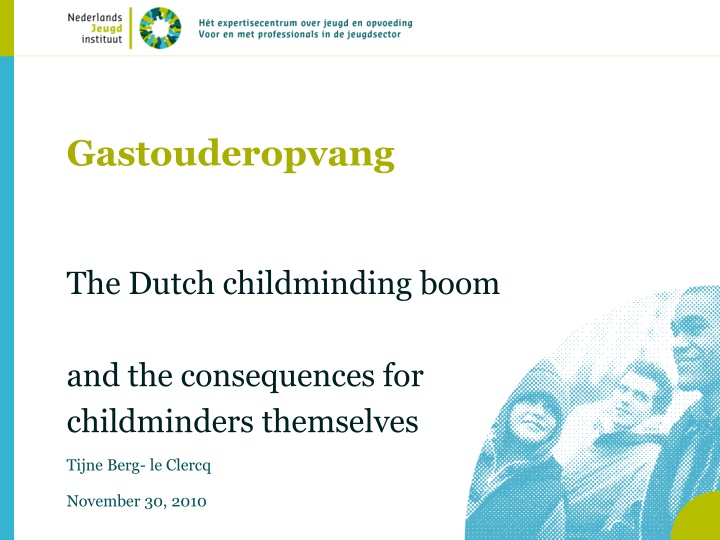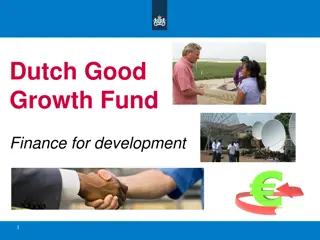Dutch Childminding Boom and Consequences for Childminders
The presentation discusses the Dutch way of organizing child care, including the childminding boom and its consequences for childminders. It covers the best ways of organizing childcare, the types of formal child care available in the Netherlands, child care allowance, and the shift towards a demand-driven financing system. The images included provide insights into the key points presented.
Download Presentation

Please find below an Image/Link to download the presentation.
The content on the website is provided AS IS for your information and personal use only. It may not be sold, licensed, or shared on other websites without obtaining consent from the author.If you encounter any issues during the download, it is possible that the publisher has removed the file from their server.
You are allowed to download the files provided on this website for personal or commercial use, subject to the condition that they are used lawfully. All files are the property of their respective owners.
The content on the website is provided AS IS for your information and personal use only. It may not be sold, licensed, or shared on other websites without obtaining consent from the author.
E N D
Presentation Transcript
Gastouderopvang The Dutch childminding boom and the consequences for childminders themselves Tijne Berg- le Clercq November 30, 2010
Outline of presentation Introduction The best way of organising child care The Dutch way of organizing child care The Dutch child minding boom The most important consequences The consequences for childminders themselves Some things never change Food for thought 2
Introduction Tijne Berg- le Clercq The Netherlands Youth Institute Knowledge broker: Importing knowledge Exporting knowledge 3
The best way of organising childcare for pre-school children (1) Three most frequently mentioned choices in 2008 4
The best way of organising childcare for pre-school children(2) Certified childminding in a private home 5
The Dutch way of organizing child care (1) Childcare Act: 3 kinds of formal child care: 1. Day care centers (0-4 year olds) 2. After-school care (4-12 year olds) 3. Registered childminders/ host care (0-12 year olds) Formal childcare does not include: Play groups Lunch break care 6
The Dutch way of organizing child care (2) Child care allowance: formal child care is paid for by: 1. Employers (1/3) 2. Parents 3. The national goverment 2009: 2.9 billion paid to parents =77% of all costs per applicant if both partners: work, attend some form of education, participate in a naturalisation course, or participate in a work re-integration scheme. And if the child care provider is included in the national child care register 7
The Dutch way of organizing child care (3) Shift 2005-2010 from a supply-driven financing system to a demand-driven financing system = end of public provision of child care services Supervision of quality by: Local governments & their municipal health service 8
The Dutch way of organizing child care (4) Households by main types of child care 9
The Dutch child minding boom (1) Number of children receiving formal childcare in 2007, 2008 & 2009 10
The Dutch child minding boom (2) Number of children cared for by childminders in NL 2006: 70.000 2007: 140.000 2008: 197.000 2009: 217.000 11
The Dutch child minding boom (3) Number of households receiving child care allowance for child minders 2006: 33.000 2007: 80.000 2008: 118.000 2009: 128.000 12
The Dutch child minding boom (4) Reasons for the increase in formal child care: the supply of after-school care facilities on primary schools a higher government contribution for the middle and higher income brackets the introduction of the compulsory employers contribution What also happened was: a substitution of informal by formal child care a minor increase in female labour market participation 13
Bekijk de afbeelding op ware grootte The Dutch child minding boom (5) Reasons for the child minding boom: Higher child care allowances for childminding Shift from informal childminding to formal childminding Wish of the mother to work/study more Child minding is financially attractive Fraud? Abuse of child care allowances? 14
The Dutch child minding boom (6) Reasons for the child minding boom: Before 2005 0 http://t1.gstatic.com/images?q=tbn:H749VPckZguyxM:http://www.leesplein.nl/assets/boeken/kaft/9073991900.jpg After 2005 5 5 3 http://t1.gstatic.com/images?q=tbn:H749VPckZguyxM:http://www.leesplein.nl/assets/boeken/kaft/9073991900.jpg http://t1.gstatic.com/images?q=tbn:CnPxL5245g-B6M:http://farm3.static.flickr.com/2170/2046331259_f887c5bb4c.jpg%3Fv%3D0 http://t1.gstatic.com/images?q=tbn:CnPxL5245g-B6M:http://farm3.static.flickr.com/2170/2046331259_f887c5bb4c.jpg%3Fv%3D0 Tax office Child minding agency Child minder 15
The most important consequences (1) Rising government expenses on child care Governmental cuts in child care allowances, in particular for registered childminding Increasing demands on childminding agencies Increasing demands on childminders themselves 16 Big societal turmoil
The most important consequences (2) Increasing demands on childminding agencies: No automatic inclusion in national child care register More demands on child minding agencies since 2008 & 2010, such as: Childminding agency is responsible for all payments Childminding agency staff must have relevant degree Childminding agency annually supports every childminder during 16 hours 17
The consequences for childminders themselves (1) Object of supervision from 2005 to 2009: Municipal health service Child minding agency Child minder Child minder 18
The consequences for childminders themselves (2) Object of supervision since 2010: Municipal health service Childminding agency Childminder No automatic inclusion in national child care register 19
The consequences for childminders themselves (3) Increasing demands on childminders themselves as of 2008 & 2010: Professional qualifications: Relevant diploma or certificate First aid on children Speak Dutch 20
The consequences for childminders themselves (4) Increasing demands on the work location of childminders as of 2008 & 2010: Seperate bedroom for children under 1 Smoke free house & smoke detectors Presence of child abuse protocol of childminding agency Number of children in the house 21
Some things never change . (1) Some demands on childminder agencies: Draw up a pedagogical policy plan Draw up regulations for the parents committee Draw up regulations for the complaints committee Certificate of good conduct for all staff 22
Some things never change . (2) Some demands on childminders themselves and their work location: Certificate of good conduct for childminders and their adult children Requirement to conduct health and safety risk inventories Sufficient play space for children 23
Food for thought Over time, childminding agencies and childminders in The Netherlands have had to meet more (strict) demands but: How many and what demands should they meet? Who should check this and how? And why? To cut government spending? To protect the children themselves? 24























